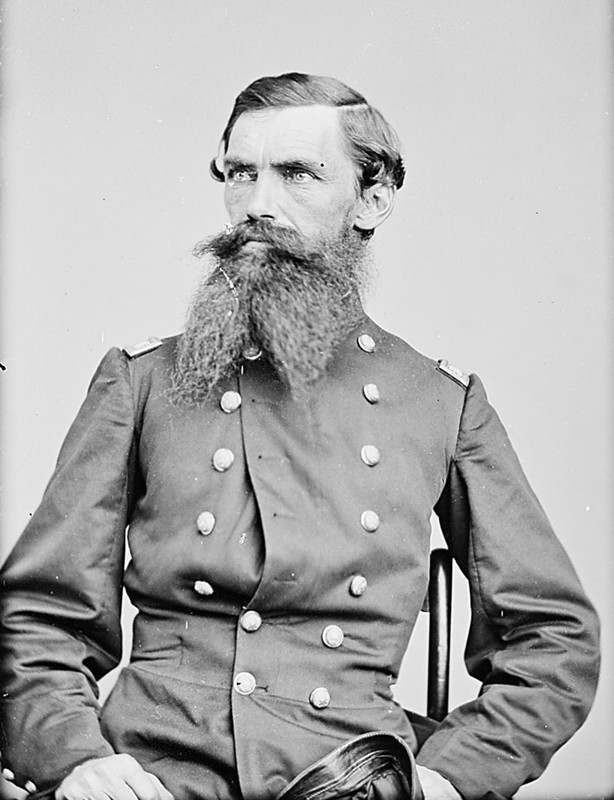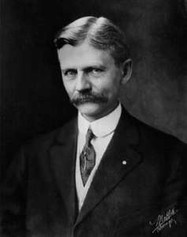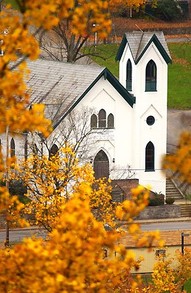Berkeley Springs Presbyterian Church
Introduction
Text-to-speech Audio
Images
David Hunter Strother in uniform. Strother served as a topographer and general's aide during the American Civil War. Courtesy of Wikipedia.

Thomas R. Marshall, vice president to Woodrow Wilson. Courtesy of Encyclopedia Brittanica.

Berkeley Springs Presbyterian Church with gabled roofs and fenestration typical of the Gothic Revival style. Courtesy of Travel Berkeley Springs.

Backstory and Context
Text-to-speech Audio
When local builder Henry Harrison Hunter completed construction of Berkeley Springs Presbyterian Church in 1874, it most likely stood out as one of the most notable buildings in the town. Designed in the Gothic Revival style with prominently gabled rooves and fenestration, the original building expanded to include a vestibule and bell tower with open belfry within the first decade of its existence. Among the trustees tasked with raising the funds necessary for the church’s initial construction were the Union General David Hunter Strother (known nationwide as the illustrator Porte Crayon) and Dr. Elisha Boyd Pendleton, a member of the local elite with familial ties to the landed aristocracy of Virginia and New York. Over the course of its history since, the church has opened its doors to a number of other noteworthy historical figures, among them Woodrow Wilson’s Vice President Thomas R. Marshall and Congressman Martin A. Morrison, both Indiana politicians who visited the area as tourists to the town’s natural springs in the early twentieth century. Since then the congregation of Berkeley Springs Presbyterian has remained relatively stable and continues to hold regular services on Sundays starting at 9:45 AM.
Prior to the Berkeley Springs Presbyterian Church’s construction in 1874, the town’s Presbyterians attended meetings held in the town of Sleepy Creek, the Cacapon settlement, and in Winchester, Virginia, disparate geographic locations that ranged from 10 to 35 miles away. That changed with the outbreak of hostilities during the American Civil War, particularly with the formation of West Virginia in 1863. After that event, a number of smaller congregations in the former western counties of Virginia began to push for their own churches, working in effect to establish their own religious infrastructures in response to the new political ones that arrived in the wake of statehood. A complicating factor in this process were the loyalties of the congregations themselves, many of which (like most faiths in the United States) split into factions over the issues of slavery and southern secession. Given its association with prominent Unionists like David Hunter Strother and selection of Reverend Edward Compston as its first minister (who had for many years served the staunchly pro-Union community of Hancock, Maryland) after the war, it is likely that the Presbyterian congregation in Berkeley Springs was largely anti-secession. This is also perhaps reflected in the fact that the congregation first applied for membership in the Presbytery of Baltimore rather than that of the more proximate Winchester, a choice that may also be indicative of the congregation’s desire to cut ties with their former state of Virginia. Ultimately, however, the Presbyterian community of Berkeley Springs failed to achieve its ends, securing permission for the establishment of their own church on the condition that it operate as a member of the Presbytery of Winchester in the Synod of Virginia. Despite this apparent early setback, the Presbyterian congregation of Berkeley Springs was able to set their plans for a new church in motion relatively quickly. While other denominations in the area struggled in the same period to raise the funds for the construction of houses of worship the Presbyterians were able to lay the cornerstone of their new church within the first year, a reflection of their denomination’s local popularity.
The involvement of a number of wealthy benefactors, most notably David Hunter Strother and Elisha Boyd Pendleton, helped speed the process by connecting the congregation to potential donors across the eastern United States. Strother (whose father operated a hotel in town in the antebellum period) served as a topographer and general’s aide during the war, and his knowledge of the western counties of Virginia ultimately proved vital to the Union’s efforts to wrest that region from the Confederate government’s grasp. After the war Strother resumed his work as the illustrator Porte Crayon, publishing his memoirs of that conflict as “Personal Recollections of the War” in Harper’s Weekly as well as a ten-part series in the same magazine titled “The Mountains” that did much to introduce the United States to Reconstruction-era Appalachian culture. The consequent fame brought by the success of these publications made Strother an ideal booster for both the town of Berkeley Springs and its Presbyterian community, which was able to secure Strother’s assistance as a trustee despite the fact that he evidently did not belong to that congregation or any other in the area. Strother’s utility as a church trustee nicely complemented that of local grandee Elisha Boyd Pendleton, whose relations in nearby Virginia and distant New York connected the Berkeley Springs congregation to pockets far deeper than those in Morgan County. Among those relations were the Boyds of nearby Berkeley County, scions of Virginia militia General Elisha Boyd (a prominent soldier and member of the House of Burgesses in the period surrounding the War of 1812). The Boyds’ fortune (one of the largest in the western counties that became West Virginia) paled in comparison to that of Pendleton’s son-in-law Eugene Van Rensselaer and his family, however. The Van Rensselaers had enjoyed wealth and prominence in New York since the period of Dutch colonization in the seventeenth century, most notably as patroons (lords) of Rensselaerswyck Manor (a semi-feudal estate that rented land to subsistence farmers in what is now part of the state capital in Albany). Eugene’s father, Stephen, had chosen to sell off most of the family’s estates and end their patroonship in the 1840s in the face of mounting pressure from tenants who were steadily joining the middle class as the United States industrialized over the period and (like many such tenants in New York) resented the anti-democratic overtones suggested by their tenancy. Still, the Van Rensselaer fortune remained among the largest in the nation after the Civil War, a fact that the Presbyterian congregation of Berkeley Springs wielded to their advantage by securing a sizeable donation from the family through Eugene’s personal intervention at the behest of his wife’s father.
After the church’s founding with help of Strother, Pendleton, and Van Rensselaer, it continued to enjoy connections to prominent figures from the nation’s past. Democratic Vice President Thomas R. Marshall and Democratic Congressman Martin A. Morrison both attended services at the church in the early twentieth century, connecting the congregation to not only the history of the Progressive Movement in the United States but the experiences of the nation during World War I as well. Marshall and Morrison were each members of prominent Unionist families during the Civil War who went on to become notable proponents of Progressive-era reforms in the early twentieth century. Morrison, who preached a sermon in Berkeley Springs on the contributions of women to the Presbyterian Church and the United States, was a prominent supporter of Prohibition. Marshall, meanwhile, served as Governor of Indiana from 1909 to 1913, securing the passage of child labor and anti-corruption laws in that state but finding his other efforts (most notably the adoption of a new, Progressive constitution) stymied by his opposition in the Republican Party. He was ultimately unable to accomplish his goal of ensconcing Progressivism at the state level in Indiana before his nomination as Woodrow Wilson’s Vice President in 1912 but continued to advocate for such reforms during his time in the White House. Doing so put him at loggerheads with the President, who largely ignored calls for Progressive reforms during his time in office and chose instead to focus on the growing conflict in Europe (a focus that further distanced the two in the face of Marshall’s opposition to U.S. involvement in the war). As a result of this distance Marshall chose to focus primarily on his role as President of the Senate, which in turn resulted in the cabinet’s decision to rest the powers of the Presidency in First Lady Edith Wilson’s hands rather than Marshall’s after the President suffered a stroke in 1919. When news of this decision reached the public later it prompted growing support for an amendment clarifying the succession process in the case of the President’s incapacity, a movement that culminated with the passage of the 25th Amendment in 1965 in response to John F. Kennedy’s assassination two years earlier.
Through its connections to figures like Strother, Pendleton, Van Rensselaer, Marshall, and Morrison, the congregation of Berkeley Springs Presbyterian Church has ties to historical events, movements, and processes that stretch from the colonial era to the twentieth century and encompass a broad geographic area extending across much of what is now the United States. The history of the church’s foundation and subsequent worship serve as a window into the experiences of a local community struggling to not only rebuild after the violence of the Civil War but to redefine itself within the context of West Virginia’s recent statehood. It is also, however, indicative of Berkeley Springs’ many ties to the world at large and its history as a resort destination for the nation’s rich and powerful. Through these ties, the community and the church itself have associations to some of the most influential political and social movements in the history of the United States. Those interested in experiencing that history for themselves may do so by visiting the church during regular worship hours on Sundays starting at 9:45 AM.
